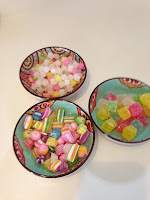Today is an annual festival day known as Hinamatsuri (ひな祭り) "Dolls Festival", commonly known as "Girls' Day." Historically speaking, the origin of the festival is not entirely clear, but most certainly began over 1,200 years ago with historic records dating back to the Heian period (794-1192 A.D.). The name of the festival itself is "Hina" which means young bird, or chick**, and "Matsuri" which of course means festival.
Traditional dolls, known as "Hina-ningyō" (雛人形) are displayed in the homes of families who have daughters. The dolls wear traditional clothing of the royal court of the Heian period. Traditionally, the dolls are displayed on a multi-tiered platform that's covered with red cloth, but these days, displays in different homes can vary significantly. The dolls you see pictured above are displayed in the home of my friend Kayoko who is the mother of two young daughters Nina and Rianna. As you can see, the dolls are quite elaborate, exquisite and beautiful. This was not the case when the tradition first began, however. Originally the festival was celebrated by making paper dolls and floating them down a local river. The reason being that the dolls have the power to contain impure spirits and carry them away from the family thus preventing calamity. The dolls of modern Japan have the same power, so it is important to pack and store the dolls away immediately after the festival is over. In fact, it is said that leaving the dolls on display past the close of the festival may result in late marriage for the daughters. The dolls are purposefully arranged and the arrangement depends largely on one's home region.
Of course there are also certain foods associated with Hinamatsuri, such as chirashizushi and snacks such as Hina-arare (雛あられ brightly-coloured, sweet, puffed rice snacks) and kompeitō (金平糖 sugar candy) and other treats (kompeitō pictured here, top left. Photo on the left courtesy of my friend, Miho). Another snack known as Hina-mochi (雛餅) and special rice wine called shirozake (白酒) are also often part of the custom.
 |
| Delicious food, overseen by Rianna |
In this picture, the display also includes a slightly less-traditional box of kleenex. (^_^)




No comments:
Post a Comment